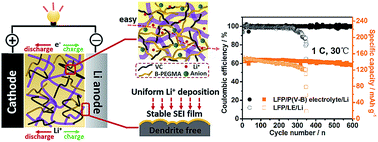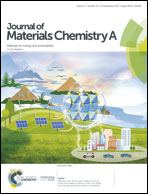A borate decorated anion-immobilized solid polymer electrolyte for dendrite-free, long-life Li metal batteries†
Abstract
Abrupt Li dendrite growth and the safety hazards caused by liquid electrolytes are generally acknowledged as major technical barriers for the practical application of Li metal batteries. Solid polymer electrolytes (SPEs) are promising to overcome these obstacles, but suffer from rigidity–conductivity inconsistency, ununiform ion distribution and inferior interfacial compatibility. Herein, an anion-immobilized SPE using vinylene carbonate as the rigid polymer backbone and flexible ether oxygen chains containing anion-trapping boron moieties is proposed, which facilitates the Li+ transport and adjusts the ion distribution. This ingenious design along with facile in situ preparation effectively integrates a favorable Young's modulus (2.41 GPa), high ionic conductivity (9.11 × 10−4 S cm−1 at 25 °C) and a high Li+ transference number (0.68), as well as achieving a stable solid electrolyte interface layer. As a result, these integrative properties enable dendrite-free LiFePO4/Li batteries with excellent rate capacity (8C, 98.3 mA h g−1) and superior long-term cyclability over 600 cycles at 30 °C, providing a new strategy for safe and high-energy all-solid-state energy storage systems.



 Please wait while we load your content...
Please wait while we load your content...